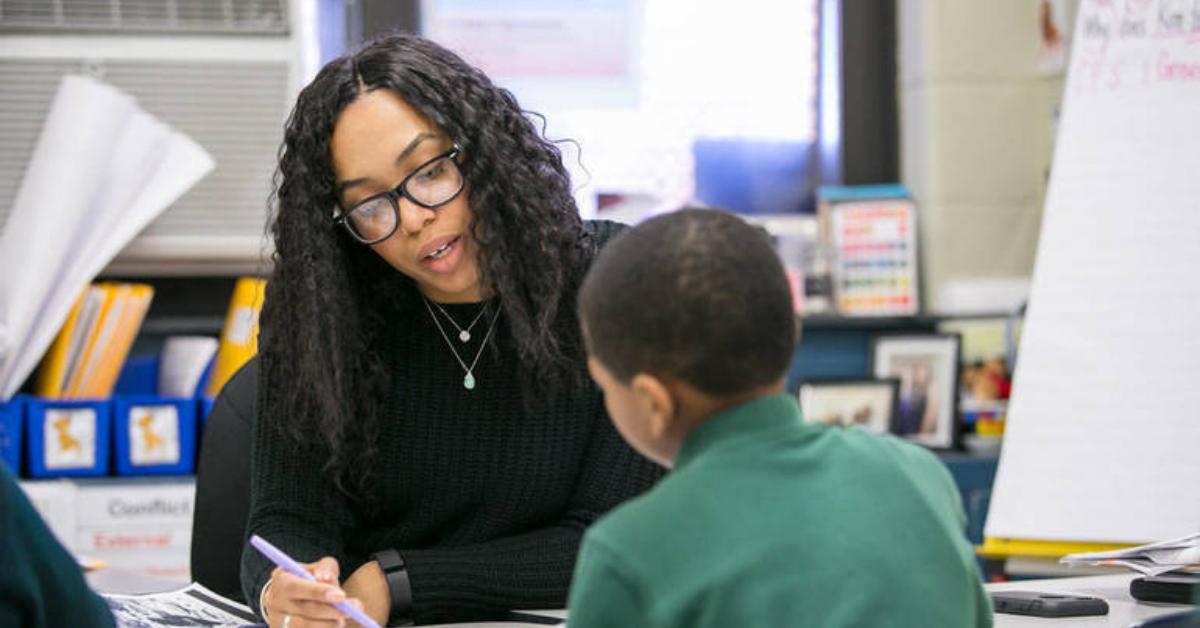
Apr 7, 2022 5:04:21 PM
by Laura Waters
When brand-new kindergartners arrive at any Uncommon elementary school, one of the first chants they learn is, “I love math and math loves me! It’s as easy as 1,2,3! Just watch and you will see!” It’s the beginning of what their teachers hope will be a lifelong love affair with math.
Equel Easterling, a fifth-grade math teacher at North Star Academy Clinton Hill Middle School, an Uncommon school in Newark, New Jersey, works hard to keep that love flowing. “We tell them they’re good in math, center praise around how hard they work, '' he says. “It sets up an opportunity for all to excel as long as they’ll work hard. Don’t let wrong answers get you down!”
While California’s latest draft of math standards has reignited the math wars, everyone involved in math education can agree on two things:
A close look at what Easterling does sheds light on the middle way between math traditionalists and math reformers.
Why Easterling? Because Uncommon’s student outcomes suggest their math teaching is on the right track. In Newark’s traditional district schools, 27% of students reach proficiency in math. At Uncommon’s North Star Academies, 53% do. The network gets similarly outstanding results in its New York State schools. These students are predominantly Black, brown and low-income, yet they are outperforming their local and statewide peers in math. What’s the secret?
Uncommon puts many smart strategies to work in teaching math. And, for a charter network with a strong no-excuses reputation, a surprising number of those strategies are touchy-feely, not kill-and-drill. For example, the kindergarten chant helps stop math anxiety before it starts. It also helps prevent youngsters from getting the idea that math is not for them.

Alexandria Timoll, Dean of Curriculum and Instruction at an Uncommon Brooklyn campus called Leadership Prep, says, “The idea that math is only for people who are good at math doesn’t apply here.”
Easterling’s focus on effort over innate ability and his acceptance of mistakes as part of learning are two tools to promote growth mindset, the belief that intelligence can be developed. Being good at math is not innate, but a process where one must get things wrong before getting them right. To encourage that process, teachers praise effort, strategic thinking, perseverance, and improvement.
Building students’ growth mindset lies at the heart of Uncommon’s approach to math teaching.
Carol Dweck, who has written much about the growth mindset, describes in this TedTalk “two ways to think about a problem that’s slightly too hard for you to solve. Do you say to yourself, ‘I’m not smart enough to solve it’? Or do you say, ‘I just haven’t solved it yet.’” Elsewhere, concerning a study of 7th grade math students, she notes that students with a growth mindset who believe they can learn anything “outperform those with a fixed mindset who believe their intelligence is fixed.” Therefore, educators must praise the effort, the focus, and the strategies to foster “kids who are hardy and resilient.” She calls this approach “the power of yet.”
Traditional math teaching strategies also have a place in Easterling’s classroom. Like many teachers, he opens his lessons with a “do now,” a few minutes of problem-solving to help students recall and reinforce what they have already learned.
He’ll throw in a chant to jog their memories, too. He calls out, “GEMDAS!” Then his students, all Black and brown and 86% economically disadvantaged, shout back the mnemonic that helps them remember the order of operations for a math problem: “Green Elephants Will Destroy a School! Grouping Symbols! Exponents! Multiplication! Division! Addition! Subtraction!”
With his students thoroughly engaged, Easterling moves on to the “Excellence Portion” of the class, a chance for students to shine as they practice math facts. Today the students line up in two rows along the length of the classroom as he holds up cards with what he calls “fast facts,” one kid after another rattling off answers to regrouping and fractions exercises, skills they’ll need when they proceed to more abstract concepts. “We are constantly practicing, challenging each student to compete with themselves. Kids love the competition,” he says.
But some math experts—most notably, Stanford’s Jo Boaler, a leading architect of California’s new math framework—are calling into question Easterling’s push for speed and memorization. The new California math framework de-emphasizes memorizing math facts and speedy answers in favor of deep understanding and the ability to solve problems in multiple ways.
To Easterling, and to many others, rapid recall of “fast facts” creates more mental room to engage more deeply with math problems. In Easterling’s view, memorization and critical thinking about math are complementary. Having the fast facts at hand helps students see opportunities to tackle problems from multiple angles. “There’s more than one way to solve a problem,” he observes.
To North Star parent Dana Madison, this approach to mathematics strikes the right balance. “It’s more than memorization,” she says. “North Star does a really good job introducing new ways of doing things that explain it, thinking about it critically, and understanding the concept.”
Easterling notes that the pursuit of excellence does not demand rigid perfectionism. When he demonstrates problem-solving, “sometimes I’ll say something wrong to model having to work toward something.”
Here, he’s right in tune with Boaler. “We’ve sort of grown up as educators thinking that we want kids to get work correct all the time, but actually that’s not what we want. We want them to be in this place of struggle because that’s what develops these really great connections,” she told hundreds of math teachers at a conference in North Carolina last summer.
When Easterling has to correct his students, he does so gently. When he walks through the room to see how students are solving problems on their own, he’ll circle the spot where a student made a mistake, “so it just feels like they have to take another step.”

He also works hard to build a classroom culture where kids feel safe making a mistake. “For students who are getting frustrated, we build a culture of ‘hey, team.’ It’s a culture of honoring and respecting each other. There are times when we get something incorrect and that’s OK.”
“The idea is not to pursue the right answer at all costs," Paul Powell, assistant superintendent of Uncommon Schools, told USA Today. "We want students to develop fluency with numbers, a conceptual understanding—each time we move a decimal place, what does that mean?—and to be able to apply what they’ve learned.”
Madison’s son Corey, an eleventh-grader at Newark’s North Star high school currently taking AP calculus AB, validates Powell’s approach when he tells me, “I think there’s a difference between understanding the logic behind a math problem and being able to do it. The teachers here try to make sure you understand the logic, the ‘why’ of it. I get the logic for most of it, although calculus is more challenging, but the teachers also make sure if you get a little lost you still know the steps.”
Getting to AP calculus as a junior was a process that started in kindergarten, Corey’s mom recalls. “His kindergarten teacher was amazing. Those kids learned. They had time to play, but she ran her classroom very well. He learned everything he needed,” she says. “They would count to 100, play games, make it fun but still challenging. He got a really strong foundation.”
As Corey grew older, North Star began to “add on, add on, add on” to that strong foundation established early. Madison got to see that progress via quarterly visits to the school’s tradition of a Community Circle, created by North Star founder Jamie Verrilli, who was inspired after watching Eyes on the Prize, a documentary about the civil rights movement.
During Circle, educators lead students in a lively call-and-response session. Madison recalls the math call-and-response vividly: students would sit on the floor in two groups, third- and fourth-graders in one, primary students in the other. The principal would ask math questions, including word problems. “Kids would do it in their heads,” Madison remembers. “No problem if you got something wrong, someone would help them out. They were really collaborating. It was really amazing what the kids could do.”
While many schools start math tracking in middle school, Uncommon schools do not. This means all students are exposed to high expectations—they all take algebra in middle school—and teachers work hard to ensure learners who need additional support get what they need.
“We have a wide range of learners, some with 504 and IEP’s. We do a lot of work planning around those students,” says Easterling.
Civil rights leader and Algebra Project founder Bob Moses, who died in 2021, would be proud that students like Corey and his Uncommon peers are getting the foundational math they need to excel. No matter where one stands in the current math wars, there’s no argument that the goal is clear: more students like Corey, who are excited and confident about math.
Laura Waters is the founder and managing editor of New Jersey Education Report, formerly a senior writer/editor with brightbeam. Laura writes about New Jersey and New York education policy and politics. As the daughter of New York City educators and parent of a son with special needs, she writes frequently about the need to listen to families and ensure access to good public school options for all. She is based in New Jersey, where she and her husband have raised four children. She recently finished serving 12 years on her local school board in Lawrence, New Jersey, where she was president for nine of those years. Early in her career, she taught writing to low-income students of color at SUNY Binghamton through an Educational Opportunity Program.
Few issues in education spark more tension and debate than standardized testing. Are they a tool for equity or a burden on students? A necessary check on school systems or a flawed measure of...
Charter schools are public schools with a purpose. Operating independently from traditional school districts, they're tuition-free, open to all students, and publicly funded—but with more flexibility...
Despite the benefits of a diverse teaching force, prospective teachers of color fall out of our leaky preparation pipeline at every stage: preparation, hiring, induction, and retention. Here’s what...
Ed Post is the flagship website platform of brightbeam, a 501(c3) network of education activists and influencers demanding a better education and a brighter future for every child.
© 2020-2025 brightbeam. All rights reserved.
Leave a Comment